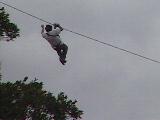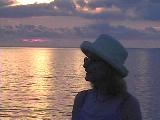Panorama
in Paradise
Costa Rica: Land of spectacular beauty, mystery and contrast April 28-May 09,
2001
On Saturday April 28, 2001, we embarked upon a dream adventure to Costa Rica. We fell in love with this small country on a shore excursion stop a couple of years ago, when the Crystal Harmony stopped here for a day on the last cruise between Acapulco and Barbados, via the Panama Canal while in US possession. We always wanted to return here and spend more time. Heavenly mountains and delightful beaches, the healthiest climate of the world, a profusion of flora and fauna like nowhere else on this planet, makes Costa Rica a true paradise. This is it. We’re on our way.
Continental flight 754 departed Seattle on time and after a change of planes in Houston, we arrived on San Jose at 8:30 pm. Seattle seems to be a long way and very long tiring flights away from everywhere!
We had reservations at the brand new Costa Rica Marriott hotel located at 700 Metros Oeste De La Firestone, San Antonio de Belen, San Jose, Costa Rica. This is half way between the Juan Santamaria airport and the city of San Jose. The hacienda style Costa Rica Marriott is set on the exquisite site of a 30 acres colonial coffee plantation and features the splendor of this plantation setting, decorated with antiques for an elegant and comfortable atmosphere, and a magnificent view from all rooms and suites of the Alajuela valley.
Certainly, Costa Rica is the ultimate paradise. This small state between the Caribbean Sea and Pacific Ocean is about the same size as Switzerland or West Virginia. Eco-tourists and retirees alike praise the abundance of fauna and flora. The country has no military, no nuclear power plants, almost no analphabetism, lots of culture and no winter. Costa Rica is open and friendly toward foreigners and Ticos. Costa Rica is the ideal country for people who want to retire from an active professional or business life and become a resident, a Tico.
LOCATION: Bordering Nicaragua to the north, Panama to the south, The Pacific Ocean to the west and The Caribbean Sea to the east, Costa Rica is only 20,000 square miles in size or 50,000 kilometers.
Costa Rica
contains more biodiversity than the entire North American Continent. Of the 33
ecological life zones identified by scientists worldwide Costa Rica contains
13, making it a mecca for birdwatchers, wildlife enthusiasts and naturalists.
Formed by the cataclysmic collision of tectonic plates, Costa Rica burst up
from the watery depths to provide the missing link in the land bridge between
North and South America. As such it became a crossroads where animals
migrating north and south mingled and came to harmoniously co-exist, as they
do nowhere else in the world. Nearly half the living things known to man can
be found here in the steamy, primeval rainforests. You can experience them
first hand on your Costa Rica, Temptress Adventure Cruise. You'll venture
through the best of the country's Pacific Coast where the most exotic natural
treasures are hidden
CAPITAL: San Jose, population 1.2 million.
CLIMATE: Essentially two seasons- the green season from May to October and the
dry season from November to April. In the Central Valley, the climate is one
of perpetual spring. Average temperature in the highlands is 72°F, along the
coast ranges from the 70's to 90's and San Jose averages 75°F.
LANGUAGE: Spanish, however English is widely spoken.
RELIGION: 90% Roman Catholic.
GOVERNMENT: Free and independent republic with a democratic government elected
by popular vote as in the U.S.
CURRENCY AND EXCHANGE: The local currency is called the colon. Credit cards
and U.S. dollars widely accepted in the main towns and aboard ship.
ENTRY REQUIREMENTS: Citizens of the U.S. need valid passport (or proof of
citizenship in conjunction with a photo I.D.). A tourist visa will be provided
by the airline. Other nationalities should check with Costa Rica and Panama
consulate offices.
Sunday morning April 29, we have an early morning pickup at the hotel for the bus ride to Tabacon Resort and Spa at the foot of the Arenal Volcano. The 3-hours-drive take us through lush forests and winding mountain roads. I would have trouble finding my way around here, since there are very few road signs and lots of options. Driving in Costa Rica is safe but difficult. Many roads are in poor condition and sometimes follow mountain streams for part of the way. Many bridges are barely wide enough for one car at a time, with no guardrails and located in a 90-degree turn. Slowly, slowly the roads are improving, as they are being paved and widened, little by little.
Located in
beautiful La Fortuna, the tranquility of the famous Hot Springs and the
comfortable stay there is an experience to last a lifetime. Tabacon Resort
offers 73 rooms and 9 Jr. suites; equipped with air conditioning, color T.V.
with satellite programming, coffee maker, hair dryer, and a private terrace
with front view of the spectacular Arenal Volcano. The Arenal Volcano,
together with the surrounding tropical rain forest, provides a breathtaking
setting unparalleled in the world.  In
the middle of this entire natural splendor, Tabacon Resort offers a warm and
beautiful heaven, where you can enjoy an unforgettable and relaxing
experience. From the heart of the Arenal Volcano and the thermo mineral Hot
Springs, which conform Tabacon, we relaxed in the many pools and springs. The
minerals waters, running at a soothing temperature of 39° C (102 F) flow
through exotic tropical gardens, forming cascades and pools, -- the perfect
setting for an unforgettable experience.
In
the middle of this entire natural splendor, Tabacon Resort offers a warm and
beautiful heaven, where you can enjoy an unforgettable and relaxing
experience. From the heart of the Arenal Volcano and the thermo mineral Hot
Springs, which conform Tabacon, we relaxed in the many pools and springs. The
minerals waters, running at a soothing temperature of 39° C (102 F) flow
through exotic tropical gardens, forming cascades and pools, -- the perfect
setting for an unforgettable experience.  It
was raining the entire 2 days we were there; hey this is the rain forest! The
mountain never peaked out of the clouds, except once did we get a glimpse of
the outline of part of the mighty Arenal, so I spent my time in the hot
springs and at the Spa. It could have been worse you know. The perfect
complement to the Tabacon Experience is Iskandria, the SPA at Tabacon, which
offers a variety of treatments ranging from facial cleansing to aromatherapy
massages, all in a natural and tropical environment. I purchased the
Rainforest package, a facial, massage and deep body cleansing. It took 4
hours, which seemed like 4 minutes and was so relaxing. I let my mind and body
get away from everyday pressure. I enjoyed the relaxation, renewal and
pampering. I was covered in mud at one point and was led down a path from the
Spa to the thermal river, stark naked, where I waded out into the river and
washed off the mud in the warm volcanic water rushing by. There was plenty of
growth around the area, so it was completely private, but I didn’t care at
this point one way or another. I was lead back inside for more massage and
treatments. The Spa is totally open to the outside, and the running waters and
the birds singing provide the soothing music, which is so relaxing.
It
was raining the entire 2 days we were there; hey this is the rain forest! The
mountain never peaked out of the clouds, except once did we get a glimpse of
the outline of part of the mighty Arenal, so I spent my time in the hot
springs and at the Spa. It could have been worse you know. The perfect
complement to the Tabacon Experience is Iskandria, the SPA at Tabacon, which
offers a variety of treatments ranging from facial cleansing to aromatherapy
massages, all in a natural and tropical environment. I purchased the
Rainforest package, a facial, massage and deep body cleansing. It took 4
hours, which seemed like 4 minutes and was so relaxing. I let my mind and body
get away from everyday pressure. I enjoyed the relaxation, renewal and
pampering. I was covered in mud at one point and was led down a path from the
Spa to the thermal river, stark naked, where I waded out into the river and
washed off the mud in the warm volcanic water rushing by. There was plenty of
growth around the area, so it was completely private, but I didn’t care at
this point one way or another. I was lead back inside for more massage and
treatments. The Spa is totally open to the outside, and the running waters and
the birds singing provide the soothing music, which is so relaxing.
Tom did the
Canopy Tour, which has become so popular in Costa Rica. The tour consists of a
series of platforms mounted in the trees of the nearby rainforest. The victim
moves from platform to platform using high-angle equipment and techniques.
There are a variety of platforms; 2 horizontal traverses (zip lines), 2
rappels and an inclined glide from the treetops to poolside. The tour begins
at the Group Reception area next to the Spa. The guides meet you there 20
minutes prior to the start of the tour to complete the paperwork and to be
outfitted with equipment. The guide then escorts you to the tour entrance.
After passing through the forest, the tour ends up in the Las Fuentes section
of the Resort where you may enjoy the thermal pools.  As
there are no washrooms on the tour, please, please make use of the facilities
at the Spa entrance, before arriving for the tour. You will be in big trouble
otherwise. This is a scary ride! And you know what could happen if you
weren’t prepared? I wouldn’t try it if you paid me.
As
there are no washrooms on the tour, please, please make use of the facilities
at the Spa entrance, before arriving for the tour. You will be in big trouble
otherwise. This is a scary ride! And you know what could happen if you
weren’t prepared? I wouldn’t try it if you paid me.
 Any
leftover time we easily spent at the Tabacon's bars and restaurants. The Bird
of Paradise Restaurant serves delicious International and Costa Rican cuisine.
Los Tucanes is the gourmet restaurant located next to the swimming pool
and wet bar. It was right next to our room, so we ended up there for a
delicious dinner. There is also a pool here with a waterfall. We would swim up
to the Wet Bar where
we enjoyed a wide variety of tropical drinks and cocktails. One delightful
thing to have is the Cocoloco at the sun deck area adjacent to the naturally
heated swimming pool. Happy Hour is also offered at the Bird of Paradise
Restaurant and Bar, located in the tropical gardens, surrounded by springs and
rain forest.
Any
leftover time we easily spent at the Tabacon's bars and restaurants. The Bird
of Paradise Restaurant serves delicious International and Costa Rican cuisine.
Los Tucanes is the gourmet restaurant located next to the swimming pool
and wet bar. It was right next to our room, so we ended up there for a
delicious dinner. There is also a pool here with a waterfall. We would swim up
to the Wet Bar where
we enjoyed a wide variety of tropical drinks and cocktails. One delightful
thing to have is the Cocoloco at the sun deck area adjacent to the naturally
heated swimming pool. Happy Hour is also offered at the Bird of Paradise
Restaurant and Bar, located in the tropical gardens, surrounded by springs and
rain forest.
We returned to
the San Jose Marriott with a lunch and shopping stop at Sarchi craft village,
renowned for its fine woodwork and crafts. Located approximately 1 hour from
San Jose, the picturesque village of Sarchí is the cradle of wood crafting
and decorating in Costa Rica, particularly known for its production of
colorful ox-carts. 
The custom of painting decorations on the carts began in Sarchí around the turn of the century. Many houses in Sarchí are adorned with colorful gingerbread trim — another example of the craftsmanship in wood for which this little town is famous. With its pink church, trimmed in pale green, Sarchí is truly a fairy tale town. In any one of the numerous gift shops visitors will find not only the traditional oxcarts and oxcart wheels in wide variety of designs and sizes, but also an astounding array of bowls, boxes, toys, statues and jewelry, as well as items in cloth, glass, bronze and other materials. This is just about the only place to shop in Costa Rica. I would not call this country a shopper’s paradise; it has no jewelry arcades or craft bazaars. This is a place to explore nature, culture, eco-adventures and beaches.
Again, we checked into the San Jose Marriott hotel.
After breakfast the next morning we departed for the Poas Volcano National Park. 9,512 feet high Poas Volcano is seismically active, pouring forth steam at the slightest change of temperature or humidity. We walked amid tropical ferns and forests filled with exotic flowers and brilliantly plumed birds. The elusive quetzal can be seen here, but of course we didn’t even hear it. The tour includes a barbecue lunch at Kecho’s restaurant on the way back.
Botos
Lagoon is a filled-up crater in the Parque Nacional Volcan Poas. Its deep blue
waters contrast with the dense tropical forest that surround it, making it the
perfect spot for the stereotypical Indian sacrifice- throwing a young maiden
into the mouth of a crater or a lagoon. Volcan Poas is one of the most visited
volcanoes in Costa Rica, because of its proximity to San Jose and because of
the luxuriant forest that surrounds the two craters. The park measures 5600
hectares, and this basaltic volcano stands at an altitude of 2708 meters
(8,200 feet) above sea level. Apart from its volcanic activity, this national
park offers four different habitats; this, in a relatively small area, is
evidence of Costa Rica’s incredible biodiversity. The four habitats are the
following: areas with scarce vegetation, a stunted forest, a cloud forest, and
an area of arrayans. There are 79 species of birds in this park, including the
robin, the hummingbird and the spectacular quetzal. Among the mammals found
here, are the coyotes, long-tailed weasels, skunks and some small felines. If
you see a green-yellow squirrel, take a good look at it, because it’s the
Poas’ Green-Yellow Squirrel, and as its name suggests, it’s only found in
this park, and nowhere else in the whole world! One of the most interesting
ecosystems present at the park, is the dwarf or stunted forest, where the
tough ferns and bonsai-type trees aren’t allowed to grow much because of the
acid rain that’s emanated from the volcano.
It’s raining
at the top, just like last time we were up here and the crater is totally
engulfed in thick clouds. What a disappointment again! We lingered a long
time, even though it’s freezing cold up here and windy too, hoping that the
clouds would clear for a moment. 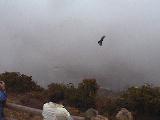 Occasionally
we think we had a glimpse so short, we can’t even be sure we saw anything
down there, since we don’t know what to look for. Oh well, now we have to
return some other time, which is not all bad. After a great lunch in the cloud
forest restaurant, our tour includes a stop at the Café Britt Coffee
Plantation. This is a treat! Imagine following the journey of a coffee bean on
the plantation – from the plant to a cup of gourmet coffee. The CoffeeTour
at Café Britt does exactly that. The professional acting troupe, dressed in
traditional garb, will escort you through a multi-media, interactive tour
through the history of coffee. Then, in the state–of–the–art theater,
sit back and watch a multimedia play and presentation of coffee’s place in
world history. Learn about how deeply coffee culture is woven into the history
and people of Costa Rica – and be prepared to have a few good laughs while
you’re at it. Although incredibly knowledgeable, the troupe has a rather
short serious threshold! These actors really enjoy performing, they constantly
seem to break into natural laughter and involve the public. This was the most
fun tour I ever went on.
Occasionally
we think we had a glimpse so short, we can’t even be sure we saw anything
down there, since we don’t know what to look for. Oh well, now we have to
return some other time, which is not all bad. After a great lunch in the cloud
forest restaurant, our tour includes a stop at the Café Britt Coffee
Plantation. This is a treat! Imagine following the journey of a coffee bean on
the plantation – from the plant to a cup of gourmet coffee. The CoffeeTour
at Café Britt does exactly that. The professional acting troupe, dressed in
traditional garb, will escort you through a multi-media, interactive tour
through the history of coffee. Then, in the state–of–the–art theater,
sit back and watch a multimedia play and presentation of coffee’s place in
world history. Learn about how deeply coffee culture is woven into the history
and people of Costa Rica – and be prepared to have a few good laughs while
you’re at it. Although incredibly knowledgeable, the troupe has a rather
short serious threshold! These actors really enjoy performing, they constantly
seem to break into natural laughter and involve the public. This was the most
fun tour I ever went on.
The evening is
spent at Pueblo Antiguo, the Costa Rica Folkloric Entertainment and Dinner
Spectacular. It’s a museum and a Folk Park at the same time also. Here we travel
through time and transport ourselves to Costa Rica in the past.  We
see the unique presentations of Pueblo Antiguo, where all the colors of the
architecture, customs and traditions are brought together to illustrate the
origins of this small country and its friendly people. We enjoyed this
unforgettable night filled with happiness and culture.
We
see the unique presentations of Pueblo Antiguo, where all the colors of the
architecture, customs and traditions are brought together to illustrate the
origins of this small country and its friendly people. We enjoyed this
unforgettable night filled with happiness and culture.
Today we will start the cruise. On the way we stop to visit to the new InBioParque, a 20 acres of biodiversity and different ecosystems experimental and research park. The Costa Rican people are so proud of their effort to preserve the diversity of their country. This park is for research and catalogue of every plant, insect, bird and animal living here.
The Temptress
picks you up in San Jose with a bus and takes you to Los Suenos at Herradura
Bay to embark the M/V Temptress Explorer. There is a brand new Marriott hotel
here where the crew has set up a lively Costa Rican style well-coming cocktail
party. They check us in here and take the bags to our cabins while we party.
Boarding goes very quickly this way, and soon we sail off into the Pacific
sunset. 
M/V Temptress Explorer Ship: An Eco Adventure Cruise.
We knew our cruise on the M/V Temptress Explorer would be no champagne-and-shopping getaway but we had no idea how much fun we would have. This ship, which cruises in Central America, features four passenger decks, a Sun Deck, Lecture room, Observation room and carries only 100-guests. On the ship's top level, the Tortuga Bar opens to the Sun Deck, a perfect lookout spot. Two lounges provide places to socialize.
What a wonderful way to discover Costa Rica: aboard a Temptress cruise ship navigating along the Pacific Coast, where the most exotic natural treasures are hidden. The Temptress Explorer accesses remote cays and beaches on itineraries that highlight the natural beauty of the region. Ideal for couples, families, or the single traveler. You will experience a wonderful all-inclusive cruise adventure where the professional crew is always ready to give a personal touch and pamper you. This cruise was unlike all our previous cruises, and may not be for everyone. What our cruise on the Temptress Explorer offered us was a journey into a landscape filled with animals and plants that we see only in zoos and arboretums at home.
After evening
presentations and leaving your shoes outside your door for the nightly shoe
cleaning service, you're all set for the next day's adventures. Each day of
our cruise was organized into morning and afternoon activities. Every
day, we're shuttled by inflatable dinghy to a coastal trailhead to begin the
day's hike,  wading
barefoot from the dinghy with hiking boots in hand.
wading
barefoot from the dinghy with hiking boots in hand.  From
ashore, passengers set out in small groups for exploration, guided by an
expedition leader. The early mornings were reserved for hikes, with three or
four different treks offered each day. The hikes varied in length from 1.5 to
3.5 hours as well as in difficulty: from easy hikes over flat land to more
strenuous routes usually described as "very difficult." You would
sign up for which group you like to go with the night before after the
presentation and explanation of the different choices. The first hike out
tended to always be the slowest one for the serious bird-watchers. They needed
30 minutes head start to stop for all the birds, before the noisy groups came
stomping through the area.
From
ashore, passengers set out in small groups for exploration, guided by an
expedition leader. The early mornings were reserved for hikes, with three or
four different treks offered each day. The hikes varied in length from 1.5 to
3.5 hours as well as in difficulty: from easy hikes over flat land to more
strenuous routes usually described as "very difficult." You would
sign up for which group you like to go with the night before after the
presentation and explanation of the different choices. The first hike out
tended to always be the slowest one for the serious bird-watchers. They needed
30 minutes head start to stop for all the birds, before the noisy groups came
stomping through the area.
A guide, who is very knowledgeable about the flora and fauna of the region, led each walk. Late afternoons were set aside for beach activities and water-sports: swimming from the beach or boat, snorkeling over reefs, or sea kayaking.
Meals are served in the Quetzal dining room in one seating between 7-9:00 pm, al fresco on the decks or sometimes even on the beach. The crew sets up everything on the beach including the bar, creating a beach party BBQ. This was always the highlight. Meals consist of delightful cuisine of fresh fruits and vegetable, and fish caught daily. The service and comfort on board this "floating hotel” fulfill and exceed your expectations.
Each of the 46 double and 4 deluxe cabins feature a panoramic picture window opening to the refreshing breeze from the sea air, 1 double or 2 single teak beds that are spacious and well appointed, individually controlled air-conditioning, and private bath with a shower and hot water. The cabins are larger than I expected on such a small ship averaging 121 square feet in size. The deluxe cabin size is 147 square feet.

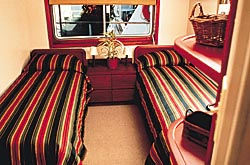
All cabins have plenty of good storage space with a closet, shelves and drawers. There are reading lamps on the teak nightstand. There are several 110 volts outlets for charging camera batteries and even to power a laptop if you choose to bring one with you on this kind of vacation. Cabin service is twice daily and free laundry service is available. The cabin doors have no locks; they have an “open ship” policy, consistent with most Cruise West ships. It is advised that you hang your camera and binoculars outside on the teak rack running down the entire hallway, to prevent fogging up when you take them from your air-conditioned cool cabin into the hot and humid fresh air outside. At no time did anyone complain about this policy, au contraire – it was a relief not to have to remember to bring keys and keep track of them when leaving the cabin. You can lock it from the inside for privacy when sleeping. Since there are no dress-up evenings on this cruise, leave the jewelry at home.

The Temptress
is 1800 ton, 185 feet long with a 40-foot beam and was built 1995, completely
remodeled 1998. Registry is Costa Rica (2001) and Panama (2002). She cruises
at a speed of 12 knots with a draft of 12.5 feet. The guest to crew ratio is
four to one, English-speaking Costa Rican crew of 25. There is no pool,
casino, spa, beauty salon or fitness center, no Jacuzzi, showroom or disco.
There are no elevators or baby-sitting services. This is a ship for
lovers of natural wonders. Nothing beats the up-close-and-personal experiences
encountered while aboard this small ship specifically designed for such
passengers. This is not a
vacation for the weary, but you need not be an experienced adventurer either.
Children as young as five years old can take part in just about everything.
Time is scheduled, but the crew understands flexibility, particularly for the
kids. There are short hikes offered to match kids' attention spans and special
meals for those who want to be out of the dining room early. "The kids
are having a ball," the mother of a ten-year-old observed, "because
they're active every single second." This is a great family vacation,
even though there are no special kid’s programs.
While it's clearly a vacation, and a stylish one at that, this eco-adventure
is also purposeful. You will experience nature with startling immediacy. And
since visiting by boat doesn't require the building of roads and hotels, you
will enjoy your stay knowing that the impact on this wondrous environment has
been minimal. There's a brand-new, giant-screen TV/VCR in the Explorer's
lounge. During our entire trip, I saw it flipped on once.
The first
morning finds us at Curu Wildlife Refuge and the afternoon at one of the
Tortuga Islands. This was the first day of a nature-oriented cruise of the
Pacific Coast of Costa Rica, a country noted for its national parks and
wildlife refuges. I awakened in great anticipation and found myself offshore
from Curú Wildlife Refuge, a 208-acre protected area that comprises patches
of dry forest and varied coastal ecosystems. Curu Wildlife Refuge is a private
reserve filled with a lush mixture of coconut palms, deciduous trees, huge
ferns, vines as thick as arms and the low vegetation of mangrove swamps.  After
breakfast we went ashore to explore the Curú Wildlife Refuge and tropical
forests and three scenic beaches, which are ideal for swimming and snorkeling.
Despite its small size, the privately owned reserve offers sanctuary to a
surprising diversity of plants and animals, including more than 110 species of
land and sea birds ranging from the great frigate bird to delicate
flycatchers, and such easy-to-spot animals as the black iguana and capuchin
monkey. Our walk took us across some swinging bridges spanning swamps and
rivers.
After
breakfast we went ashore to explore the Curú Wildlife Refuge and tropical
forests and three scenic beaches, which are ideal for swimming and snorkeling.
Despite its small size, the privately owned reserve offers sanctuary to a
surprising diversity of plants and animals, including more than 110 species of
land and sea birds ranging from the great frigate bird to delicate
flycatchers, and such easy-to-spot animals as the black iguana and capuchin
monkey. Our walk took us across some swinging bridges spanning swamps and
rivers.  This
ecosystem is located within the Tropical Dry Forest. This is a colorful
Kingfisher bird.
This
ecosystem is located within the Tropical Dry Forest. This is a colorful
Kingfisher bird. 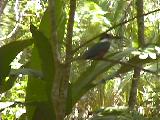
From Curú we
cruised over to beautiful Tortuga Island during lunch on the Sun Deck of fish
and chicken with plenty of fresh vegetables and fruit for vegetarians. Here
the white sand is washed by emerald green water, inviting us in for a
refreshing swim. Other choices were a canopy tour, sea kayaking, volleyball,
or simply relaxing in the soft breeze under the shade of a coconut palm in one
of the hammocks. We opted for the Tortuga Island hike. It took us to the top
of a hill from where the views were great of the beach below.  A
couple of parrots took a liking to Tom’s hat.
A
couple of parrots took a liking to Tom’s hat. 
A BBQ dinner was prepared and served on the beach here, complete with an open bar and a bonfire. People come from the capital San Jose for a daytrip here, but after 3pm everyone has to leave to get back to the city, so Temptress arrives in the afternoon when we have to beach to ourselves.
This is the difference between a land vacation and a cruise experience. During our six days on board, we explored tropical forests of both the wet and dry varieties, and saw numerous monkeys, exotic birds & parrots, lizards as small as a finger or as long as a man's leg, delicate orchids and other wildly colorful exotic plants. We visited areas only accessible by ship. Free snorkeling equipment and sea kayaks are provided for our beach activities. The guided hikes are included as part of the cruise fare. There are no extra charges to worry about.
Tipping guidelines are $10 per person, per day to be shared by all crewmembers.
It’s Sunday
May 6th and here we are in Corcovado National Park and Conservation
Area that the locals call Caletas. It is located just 75 miles north of the
Panamanian border on the west coast of the Osa Peninsula, which is
known for its old-growth forest and outstanding biodiversity.
This is one of the least visited areas in Costa Rica’s national park system.
This 100,000 acres sanctuary of biological diversity dominates the
entire Osa Peninsula in southwest Costa Rica.
We’ll take the launches ashore for an early morning bird watching
walk and the Caletas area hike. The scarlet macaws are the most spectacular,
as they loudly announce their arrival with high-pitched squawks. They prefer
to roost in the tops of the towering trees. A cry like a puppy alerts us to a
toucan hopping through the trees, with its outlandish yellow bill.  This
toucan called us and posed for a picture. The park’s 13 habitats are
characterized by an abundance of endangered wildlife, including all four
species of monkeys and six species of wild cats found in the country. Here
we learned about the endangered wildlife and the impressive giant trees
draped with vines and lianas, and supported by massive buttress roots,
towering over the forest floor, while
listening to and watching for the nearly 300 species of birds living in
Caletas.
This
toucan called us and posed for a picture. The park’s 13 habitats are
characterized by an abundance of endangered wildlife, including all four
species of monkeys and six species of wild cats found in the country. Here
we learned about the endangered wildlife and the impressive giant trees
draped with vines and lianas, and supported by massive buttress roots,
towering over the forest floor, while
listening to and watching for the nearly 300 species of birds living in
Caletas.
Horse back
riding was also offered here. We
walked up a streambed that was the trail on and off on the way to a waterfall.
Here we could go for a swim. 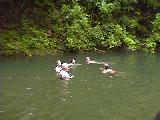 The
sounds of the forest and the birds are astounding and our guide pointed out to
us what we saw and heard. That way the entire experience became more
meaningful and memorable. Where are those leaves going? Hint: ask the ants
carrying it. What is the flower called that you can wear as lips?
The
sounds of the forest and the birds are astounding and our guide pointed out to
us what we saw and heard. That way the entire experience became more
meaningful and memorable. Where are those leaves going? Hint: ask the ants
carrying it. What is the flower called that you can wear as lips?  Marina
is demonstrating. The Caletas beach
offers areas for kayaking, swimming and snorkeling.
Marina
is demonstrating. The Caletas beach
offers areas for kayaking, swimming and snorkeling.
The ship moved
a bit and we anchored off the Josecito beach in Drakes Bay. This was a
favorite refuge for pirates during the 1500’s. It was named after Francis
Drake who visited here in 1574.  The
crew had arranged for another wonderful BBQ on the beach. After a delicious
luncheon buffet on the beach, we took the opportunity to paddle a kayak up the
Aguititas River, which is more like a stream, and to enjoy snorkeling off the
beach, swimming underneath a waterfall, and relaxing in the sun.
The
crew had arranged for another wonderful BBQ on the beach. After a delicious
luncheon buffet on the beach, we took the opportunity to paddle a kayak up the
Aguititas River, which is more like a stream, and to enjoy snorkeling off the
beach, swimming underneath a waterfall, and relaxing in the sun.
On Monday morning we’re in Golfo Dulce, a large Pacific Ocean gulf, a region less than 30 miles from the border with Panama. Dolphin and flying fish escorted the ship as we cruised the bay here.
Located on the
eastern shore of the Golfo Dulce is a little slice of heaven – an 800-acre,
palm-lined and orchid-trimmed beach, where we’ll visit the privately owned
Casa Orquideas. 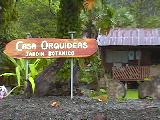 An
extensive collection of orchids highlights this remote location. We get a
private tour of this House of Orchids, a spectacular botanical garden owned by
an American couple. The display of orchids
An
extensive collection of orchids highlights this remote location. We get a
private tour of this House of Orchids, a spectacular botanical garden owned by
an American couple. The display of orchids 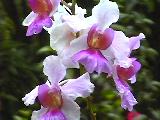 and
other flowering trees and enough spice plants of pepper, cilantro, cinnamon
and lemon and lime trees would be the thrill of any chef. The masses of
ornamental tropical plants attract a multitude of birds and butterflies. Here
we took advantage of the opportunity to see, smell, taste, and touch a wide
variety of beautiful ornamental plants, palms, cycads, and orchids. Also the
fruit from trees and other edible plants that thrive in the tropics were
available here to taste.
and
other flowering trees and enough spice plants of pepper, cilantro, cinnamon
and lemon and lime trees would be the thrill of any chef. The masses of
ornamental tropical plants attract a multitude of birds and butterflies. Here
we took advantage of the opportunity to see, smell, taste, and touch a wide
variety of beautiful ornamental plants, palms, cycads, and orchids. Also the
fruit from trees and other edible plants that thrive in the tropics were
available here to taste.
During lunch on Sun Deck, the ship cruised a short distance past Golfito, a banana-exporting port that fell on hard times after the United Fruit Co. shifted its operations elsewhere after labor disputes in the 1980s. The city is actually 2 towns strung out along a coastal road with a backdrop of steep thickly forested hills, which make up the Golfita National Wildlife Refuge.
The children
might enjoy water skiing in this calm bay. Or simply enjoy a tranquil
afternoon on the secluded beach. In the afternoon, we'll swim or snorkel in
beautiful turquoise waters with prolific coral reefs teeming with colorful
tropical fish. We’re also at the foot of the rain forest, so we can take a
hike seeing toucans and monkeys. We choose to hike the 3 hours up hill to the
Zamia Project. It was very hot and humid, but the hike up was interesting. We
found all kinds of plants and several huge termite nests. The last part was
very steep. The Zamia Project was uninteresting but there was a building at
the very top  providing
shade and a place to sit and take in the fantastic view of the blue waters
below.
providing
shade and a place to sit and take in the fantastic view of the blue waters
below.  It
was worth the hot hike up for this view. Drake Bay is one of the most
beautiful beaches in the area.
It
was worth the hot hike up for this view. Drake Bay is one of the most
beautiful beaches in the area.
This evening
the Temptress brought onboard a local band that played music for dancing with
the crew on the Sun Deck preceded by Happy Hour. We had a great time and soon
the band had to go ashore before we could sail off into the night on our way
to Manuel Antonio. 
The last day
is spent at Manuel Antonio National Park, a 1700 acres first declared a
protected zone in 1970. Manuel Antonio is one of the jewels of Costa Rica's
national park system. While it is classified as a Humid Tropical Forest, its
flora and fauna are representative of Dry and Humid Forests alike. One of the
most beautiful places in the world and one of the highlights of our cruise
this preserved parks awaited our visit to its three long strands of white-sand
beach, its exuberant jungle of well diversified plant species and open forest
trails. Iguanas, squirrel monkeys, the lazy three-toed sloth and other
wildlife are in their natural habitat here in the park and can feel safe here,
since they are protected inside the park bordered by the magnificent Pacific
Ocean. The hike is all on flat land here and very easy. We saw many sloth; one
three toed sloth came down to the ground, which it only does every 2-3 weeks
to do its “duty”.  This
is the only time a sloth comes down the tree. It was the fastest moving sloth
ever seen, ‘cause you could actually see it move! White Faced monkeys were
busy steeling the food from the beach goers and making off with it up the
trees.
This
is the only time a sloth comes down the tree. It was the fastest moving sloth
ever seen, ‘cause you could actually see it move! White Faced monkeys were
busy steeling the food from the beach goers and making off with it up the
trees. 
After lunch on the Sun Deck, prepare for an afternoon of water sports and leisure time on the beach, beachcombing, or just relaxing.
The sightseeing in the forests was exceptional. The guides cheerfully shared their knowledge of the forest, all the while keeping a watchful eye on those hikers who seemed to have difficulty making the treks. All the guides carried binoculars, which they shared for those without, and one even had a spotting scope on a tripod, which was great for spotting birds and the shy animals that live in the lush jungle.
And animals we did see: spider and white-faced monkeys; the brilliant scarlet macaws; the small lizards known as geckos and their three-foot-long cousins, the green and black iguanas; toucans; hummingbirds and many sloth, both the 3 toed ones and the 2 toed cousins. The foliage we saw was no less wonderful. Wild orchids, from the size of a pea to some as large as a tulip, hibiscus, birds of paradise, coconut palms, breadfruit, papaya, lime and lemon trees, pink bromeliads, and countless other flowers. We spent the afternoon eating lunch on Sun Deck, swimming and kayaking. The park closes at 4:00 pm so a BBQ grill buffet was served onboard for dinner
The end of our cruise arrived far too soon. The busses left early after breakfast. We drove over a bridge where we observed many crocodiles basking in the sun. We returned to Los Suenos at Herradura Bay for our transfer back to San Jose in plenty of time for the 1:00 pm Continental Airlines departure for Houston. We arrived Seattle after 11:00 pm.
Please check my website for many more pictures at http//www.winwinvacations.com or http://www.smallcruiseshipspecialist.com


